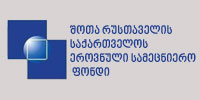The research project Integration and Identity includes the study and analysis of the lives and art of emigrant Georgian artists currently living and working abroad. The project was implemented in 2017-2019 under the auspices of the Institute of Art History and Theory of Ivane Javakhishvili Tbilisi State University, and was funded within the Fundamental Research Grant Program of Shota Rustaveli National Science Foundation.
The issues raised by the project are topical for critical studies of Georgian art, since scholarly research generally fails to cover the significance of Georgian painters and artists abroad. Yet artists help determine the progress of cultural integration of Georgia into the West, while simultaneously enriching the national art space with different aesthetic values brought from the West.
In order to perform analysis, the research group members compiled lists of Georgian emigrant artists, then classified the artists according to the spheres of their activities and countries where they live and work. During the study, research group members traveled to many European countries where expatriate artists reside (Austria, Germany, Switzerland, France, Belgium, Netherlands, Greece, England) and to the United States. The project’s research scope covered 115 artists from age 25 to 80, whose major period of emigration falls between the 1980s and the 2000s. To complete the study, participants utilized research into art history, comparative methodology, interview–sociological survey, archival research and scholarly analysis of art works. Our survey attempted to determine how organically the artists who had immigrated from Georgia merged with the western environment, the nature of their achievements and their conscious connection to the national traditions of Georgian art. On the other hand, researchers inquired as to how specifically – the label “Georgian” is affixed to their art when it is viewed abroad, under what conditions of cultural integration.
The research group members studied the theoretical and visual material and conducted interviews; they worked on relevant literature, analyzed material, observed the art of immigrant artists in connection with both Western contemporary art and Georgian art. Based on the analysis and study of artistic values and philosophical attitudes of the artists it was determined why, when, and how the artists emigrated abroad, how they settled on a new place, how they integrated into the Western environment and what connections they established with local art institutions. How do they evaluate the ongoing art processes? Do they consider their art as a part of Georgian art or not: what kind of connections are kept with the Georgian art space, what are their conscious attitudes towards the Georgian art tradition; how “Georgian” they perceive their own art in the context of such cultural integration, and what import it has towards the general integration of Georgian culture in the West.
In the framework of the research, we analyzed the lives and art of Georgian painters abroad during the 1910s-1920s. Records in archives, museums, private collections and libraries in Georgia were utilized in research. According to theoretical, documentary and visual materials, we made parallel studies of the migration processes of those earlier painters and the artists who have emigrated since the 1990s.
We searched for similarities and differences between these two events of modern Georgian art history, and also, generally, between the similar ongoing events in the world; identified the place and importance of Georgian emigre artists in the context of Western modern and contemporary art.
Several scholarly essays, conference papers and fundamental studies were prepared in Georgian and English languages based on the research-analysis carried out within the project. Ivane Javakhishvili Tbilisi State University now houses the newly created database and web-site based on the study findings. The website contains the scholarly works prepared within the project.


